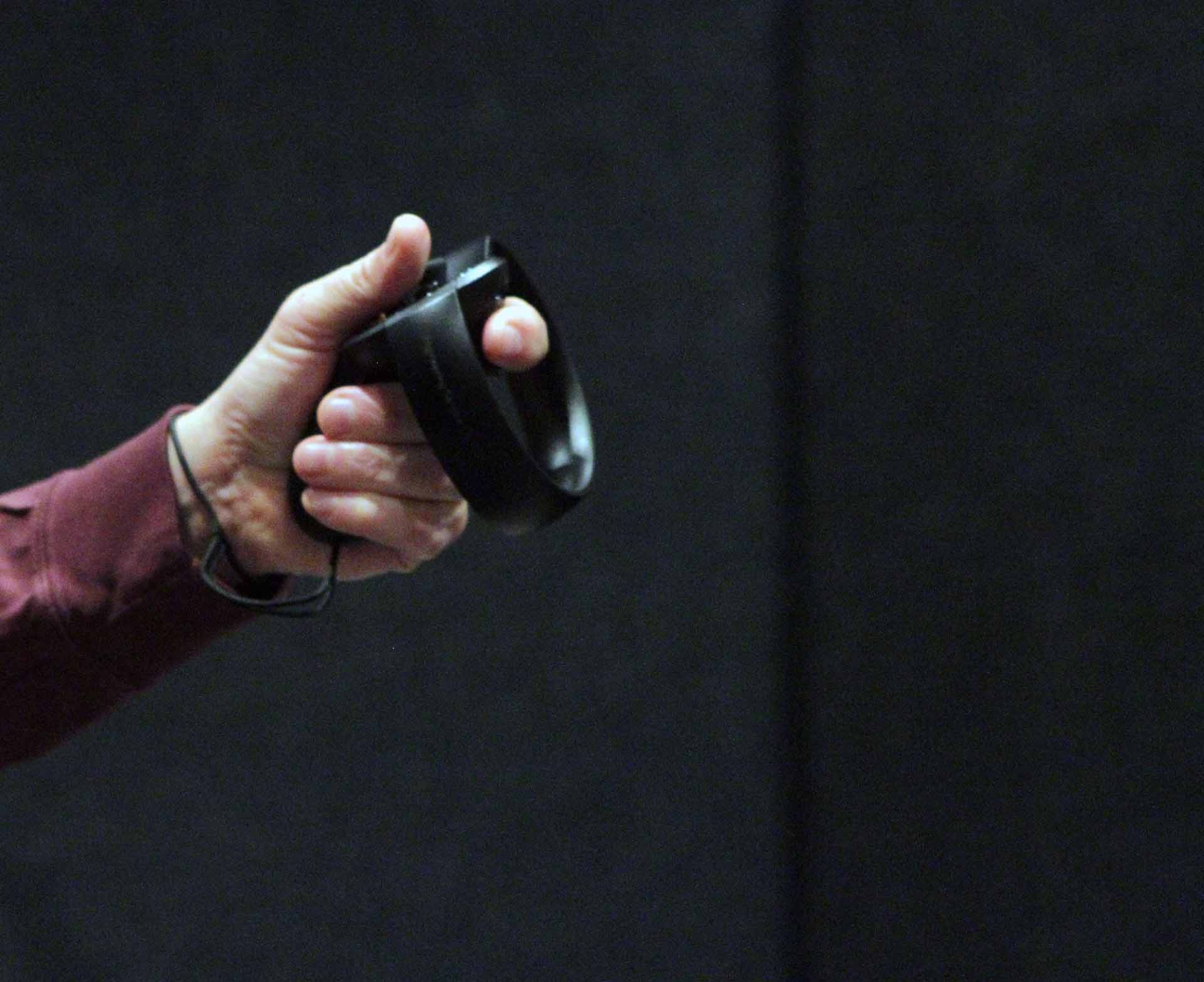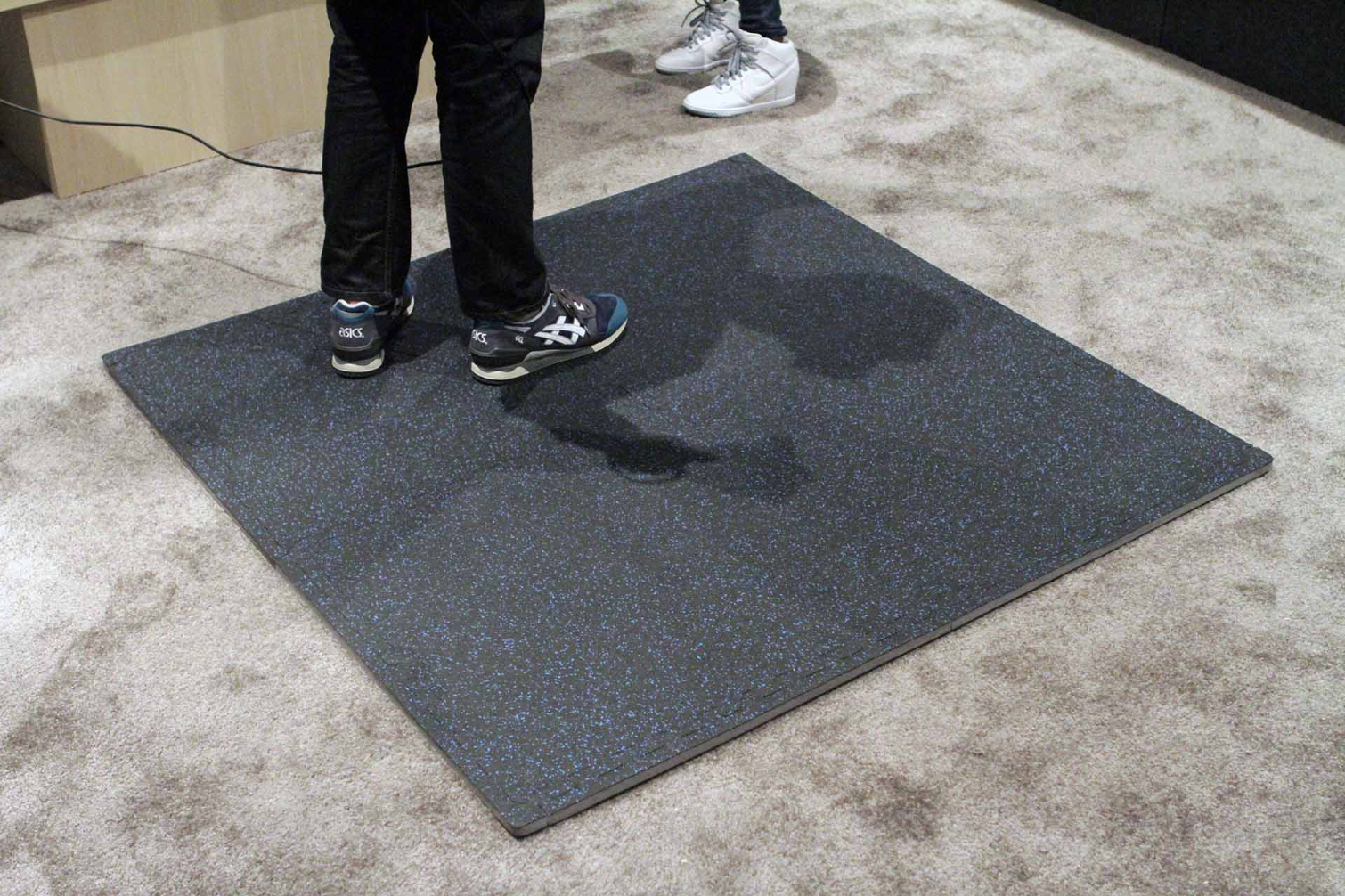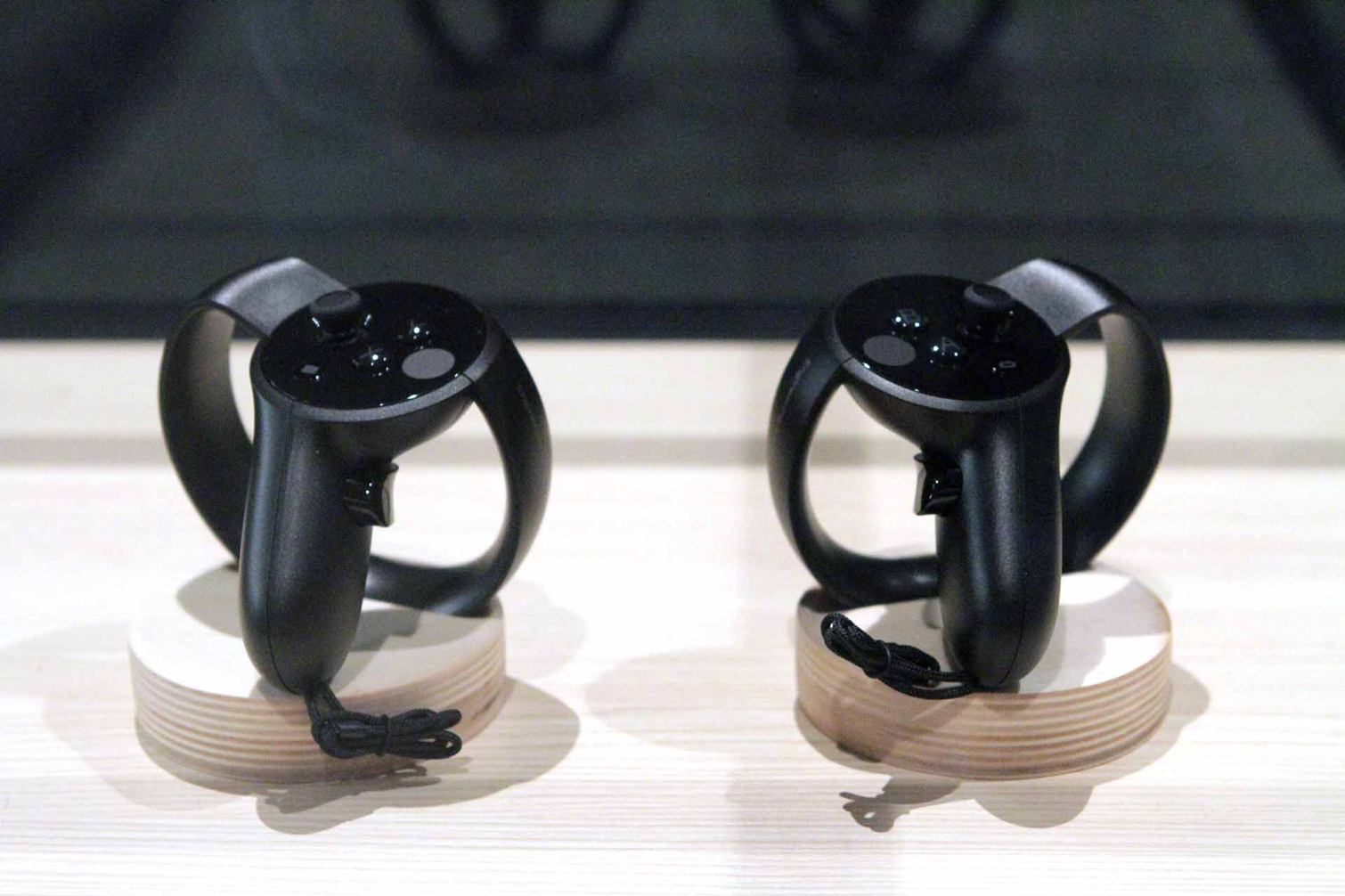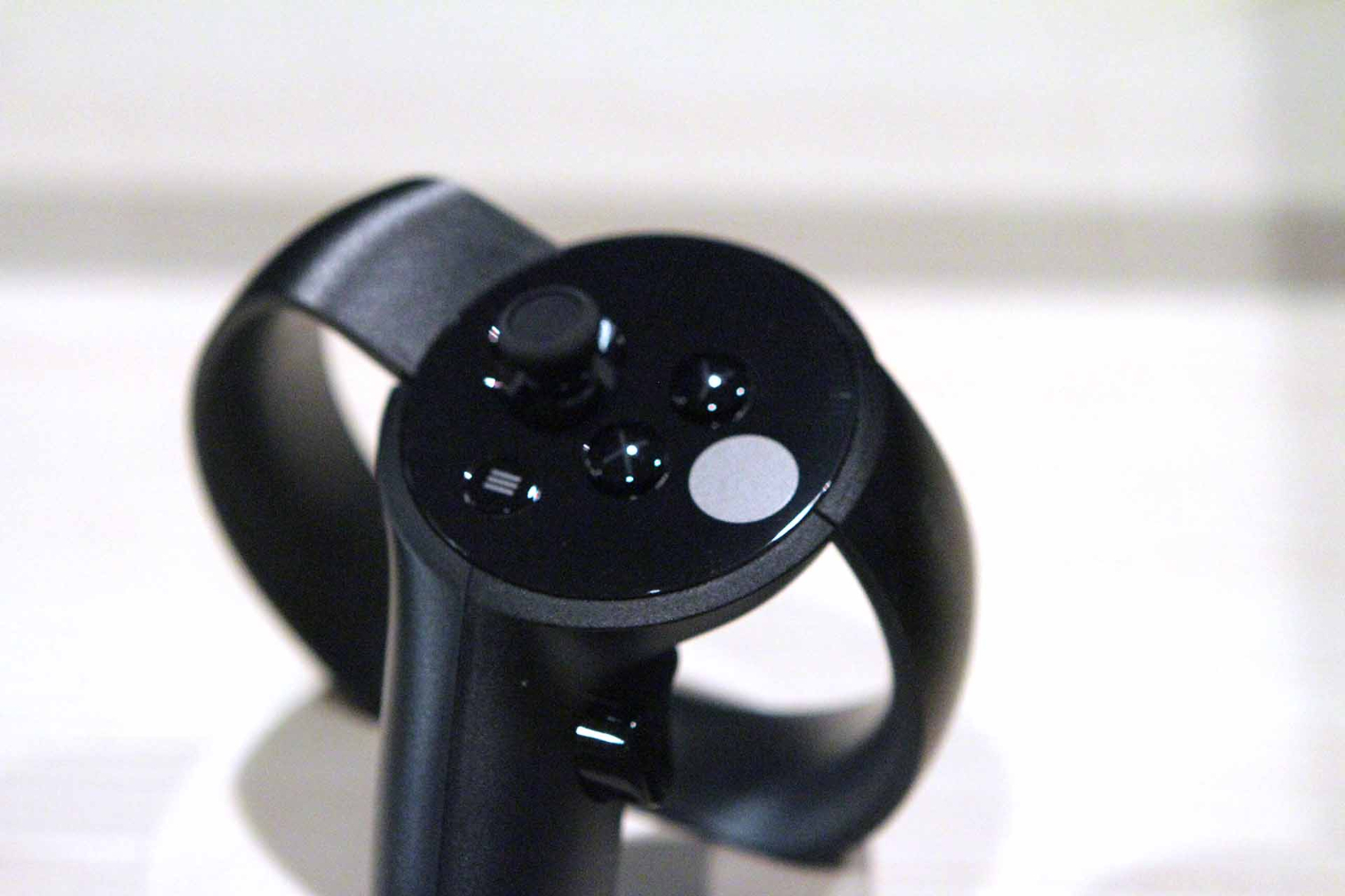Oculus Touch Controllers: The Good And The Bad
It’s been a year coming, but Oculus finally announced when its Touch Controllers will be available. And although adding Touch to the Rift is a huge step forward for the consensus number-two VR system, there are some remaining shortcomings.
Three Digits, Not Five
With the Touch controllers, you see a facsimile of your hands; the games track the controllers and make them look like hands, but your physical hands are not recreated in the virtual world in any way.
The rendered avatar of your hands shows five fingers, but you can use only three digits: your thumb, index finger, and a mittened mash of your other three fingers. Thus, you can point and give a thumbs up, but otherwise it’s like one hand clapping. You can’t, for example, flip the bird.
There’s a trigger button on the front of each controller that suits your index finger nicely, and there’s a button mounted on the handle that you actuate any time you squeeze the controller. There are also A and B buttons (or X and Y, depending on whether you’re talking about the left or right controller). In many games, you use a combination of those buttons to perform certain actions. In some games, like Insomniac Games’ The Unspoken, and Force Field’s Landfall, you make use of practically every button on the controllers.
Making three of your fingers into a fused mitt is less than ideal, and in our opinion it dings the immersion a bit, but it’s something you get used to quickly. It helps that many of the actions you perform involve gripping a gun handle or grabbing a large item or (one of our favorites) backhanding a villain in the face, none of which require that all of your fingers move independently of one another.
Boxed In And Tethered
One of the first things we noticed was that the demo mats for all the games at Oculus Connect 3 were small--about four feet square--which means that although the Touch controllers bring a whole new dimension to the Rift, they don’t give you the freedom that the Vive’s roomscale VR does. (Some of the experiences were even seated rather than standing.)
You can take about one step forward, back, left, or right, and you can duck, crouch, shimmy, sway, and shuffle, but you can’t walk. This may change a bit with the impending Guardian roomscale capability, but it's presently a limitation.
Get Tom's Hardware's best news and in-depth reviews, straight to your inbox.
You’re also still tethered. The Touch controllers can’t make that cable go away.
Floating Hands, Floating Holsters
Although we didn’t find it terribly distracting, we noticed that in every demo, your virtual hands just float. You have no arms. If you look down in, say, a shooting game, your holsters are floating, too. You have no body and no legs, which feels rather strange.
Even in an engrossing game like I Expect You To Die, the lack of lower limbs is stark. At one point, you have to depress the gas pedal of a car--which you have to do by using your hand and one of the Touch controls.
Retrieval And Teleportation
Moving around within a VR environment is one of the most challenging aspects of designing an experience. Even with the Vive’s 15x15-foot roomscale capabilities, you’re limited to walking around in that finite space. If you want your character to move any distance beyond that, you need a clever solution. Devs quickly found that some methods of movement leave users terribly nauseous, so many of them developed innovative solutions.
The most common of these is teleportation. Every game dev does it a little differently, but essentially, you use a hand controller to point to a spot you want to travel to, and with the click of a button, you’ll suddenly move.
Another method is what you might call “retrieval.” Similar to the mechanic of pointing a hand controller and clicking a button to teleport, you can retrieve objects in many titles by pointing the controller at a thing and pressing a button to “pick it up.” This works for things like grabbing ammo or health, but some games let you also use a sort of tractor beam to draw objects into your hand. (It’s kind of like using the Force in some cases.)
Teleportation and retrieval each have their merits, and we saw a lot of both during the pre-show demo day.
On one hand, both mechanics are completely unnatural and therefore can break immersion. On the other hand, there are capitulations you have to make, and teleportation and retrieval are clever solutions, given the current limitations of VR. Some developers recognize that teleportation is a break with reality, and will either extract strength from a character that uses it, or limit your use of teleportation. For example, requiring a certain amount of time to pass before using it again.
At any rate, the Touch controllers make both teleportation and retrieval easy and intuitive. For example, with an Xbox controller, you would have to look at a spot in the game and press a button to teleport. Now, it’s a smoother, more intuitive point and click. In some games, an item would be just out of reach, and because we couldn’t take two steps to go grab it, we would have to use the retrieval mechanic on something that was maybe three feet away. It was a little odd.
However, some devs use the retrieval mechanic to glorious effect, such as in Space Pirate Trainer where you can “lasso” a flying robot and whip it onto the ground to smash it to pieces. In I Expect You To Die, you can use a combination of retrieval and a button press to grab, retrieve, and suspend an item in the air--such as the paper with the instructions you need to diffuse a bomb.
In fact, even when teleportation and retrieval felt a little strange, the experience of using them was smooth and flawless. Eventually, you start using them intuitively.
Aiming And Accuracy
We noticed a bit of inconsistency game to game when it came to aiming, and it became apparent with two zombie-killing games. For example, in Killing Floor, it was tough to hit our targets with the pistol we had. In the game, you stomp around a dark, scary wood with a partner, dodging zombies. (By “dodging” we actually mean “engaging them at every opportunity,” at the expense of the mission at hand.)
When we saw the former humans emerging from the fog in the distance, we could almost never hit them with a shot. By contrast, in Zombie Riot, we could hardly miss; we racked up headshot after headset with pistols, and we found that we could blast two separate waves of zombies--one with each uzi-wielding hand--without really looking.
The Killing Floor team (Tripwire) noted that their game has no aiming assist enabled, which can make it seem like the game’s targeting is befouled, if you think you’re on target. But it’s a sort of PEBCAK issue. “Sorry, but you just aren’t that great a shot,” ribbed one of them. (No offense taken.)
There are pros and cons to the aiming issue. Zombie Riot, for example, is a blast (pun!)--you just obliterate wave after wave of cartoonish (but still somehow scary) zombies--but it’s almost too easy, which can make the game boring, eventually. The only time we ran into any trouble was when we were fiddling with the shotgun in the last stage. (It’s a pump-action weapon that requires both hands, but you can’t pump-and-shoot; you have to actually let go of the barrel and then grab it again before you can pump.)
It’s also worth noting that the inability to cap zombies from afar in Killing Floor forced us to approach the horde differently. The demo takes place at an early level of the game, so you have only your pistols and a pair of knives (and your fists, it turns out) with which to defend yourself. In short order, I found that keeping a pistol in one hand and a knife in the other gave me both midrange and short-range weapons. (You can also throw the knives. Guess who has two thumbs and had at least two knife-throw headshots in the demo? This guy.)
However, sometimes throwing things was tricky. For example, in Giant Cop (a weird and wonderfully off-putting game in which you play as--wait for it--a giant cop), you have to reach down and pick up tiny citizens and throw them into a black void. (Like we said--weird.) But throwing them with any accuracy was nearly impossible. We tried chucking them overhand, flicking them side-armed, tossing them underhand--but all methods felt flawed. You have to figure out how to hold your wrist and time your release to accommodate for the Touch controllers; they somehow created an artificially incorrect angle.
Grabbing Things Is Easy
There are really two functions that Oculus had to absolutely nail with the Touch controllers: shooting stuff and grabbing stuff. The shooting part was easy enough--point, pull trigger, enjoy--but being able to grab things intuitively was certainly a more difficult challenge. It requires your digits to offer a certain level of precision, and it has to be perfectly intuitive.
On this, Oculus scored relatively high marks. There’s room for improvement on the precision, but on rare occasions did we find that we “missed” when we reached for something. Almost always, my virtual hand was where my brain thought it should be, and when I closed my hand, it picked up the thing I wanted, with no lag. That may sound overly simplistic, but that’s the point: Grabbing things just worked intuitively. The end.
Speaking of intuitive hand gestures, some games require you to use your index finger to point to something or to press a button. It’s, again, completely intuitive to extend your actual finger and see it’s rendered avatar do the same thing. Of course, you receive no tactile feedback when you press a virtual button, but we found that we could point and press accurately even so.
Ow My Wrist
The Touch controllers are lightweight, and for the most part, the buttons and triggers all fit neatly under your hands and fingers. An informal survey will tell you that people with hands of various sizes all seem to think the controllers feel comfortable. We concur, with a couple of exceptions.
The middle trigger button--the one mounted on the shaft of the Touch controllers--is designed so that it engages any time you squeeze your hand. It’s the primary means of “grabbing” something; extend your hand and close your fist, the trigger actuates, and you pick up some virtual object. It looks to me as though that button is designed such that the pad of your middle finger hits it, but with my largish paw wrapped around the device, the middle knuckle of my middle finger is where I made contact with the button. I felt that I lost a certain amount of control there.
Not only was I striking the button with an awkward part of my finger, the button’s actuation is light and fluid, and the travel is short. Thought of one way, there is no alternative; if you want to simulate natural gripping, you want the buttons to disappear in a way. However, if that button had a little bit of tactile feedback, you could feel when you were actually grabbing an item. And if there was a big give in the travel, you could actually get more control. Presently, you’re either grabbing something, or you’re not. But that’s not natural.
Take a pistol, for example. You may hold one more lightly in your hand while moving or thinking, gripping it more firmly only when you raise the weapon to fire. With the Touch controllers, you can’t do that.
Worse, if you relax your tight grip, the thing in your hand will fall to the ground. A few times, I lost some immersion when I instinctively relaxed my grip after a wave of adversaries, only to see my virtual item drop to my feet.
A side effect to this constant gripping is that your wrist and hand tire quickly. You can see this for yourself with any item. Go ahead--grab something nearby and examine it. If you’re just holding it, you maintain a lighter grip. Now imagine that you have to use that thing as a weapon. What do you do? You instinctively grab it more firmly. Now imagine trying to maintain that tight hold for more than a few minutes at a time. You’ll need to pop some ibuprofen and ice your wrist and forearm before your lunch break is over.
Improvisation And Discovery
As anyone who follows VR knows, the key is immersion, immersion, immersion. When you get immersion, things are fabulous. Anything that breaks immersion is to be avoided at all costs. But with this spate of games, we noticed something else that significantly contributes to the experience: the ability to improvise.
On multiple occasions, we found ourselves resorting to some tactic, just as an instinctual reaction to something in a game. For example, no one told us that you could punch in Killing Floor, but when a zombie popped up and I had to fend it off, I did so with a fist, because that’s all I had. The same thing happened when I played Super Hot. In Robo Recall, Fritz discovered quite by accident that you can grab bullets out of the air and whip them back at the wayward robots, and later in the demo, he suddenly realized that he could grab a robot, rip its arms or legs asunder, and bash it over the head with the detached limb.
Discovering a game mechanic is thrilling. You feel like you’re the smart one, not the game dev who spent weeks figuring out how to make that particular move work perfectly in their game.
When you have so many natural-feeling methods of interacting with a game, you begin improvising, and there’s some magic to that. It’s not merely that you customize your weapon loadout; a thousand games give you that option. It’s that, for example, you can customize your loadout and tailor it to your movements, and you can find a flow that works for your body and its strengths. Unlike with 2D games, it’s not about how quickly you can apply button combinations; it’s how fast you can attack with your knife in tandem with your sidearm, how agile you are at dodging attacks and projectiles, and so on.
Take a game like I Expect You To Die, for example. It’s a combination spy thriller and puzzle game, and there are multiple ways to solve each puzzle using the objects in your environment. It’s not simply that you have to figure out A, B, and C to solve the problem and escape; you have to figure out how to solve A, solve B, and solve C however you can.
Lag? What Lag?
None of the aforementioned mechanics or controls work if there’s too much lag between your physical action and a corresponding virtual action, but the Rift and its Touch controllers have no such issues.
In grabbing, shooting, punching, slicing, and occasionally dicing, we were struck by how fluid and instantaneous our movements were within the VR environments. We’ve played a number of games over the years where even small tasks like holstering a pistol is awkward and laggy, and when that happens, your immersion is cracked open. But the Touch controllers and the games we played with them deliver such a smooth experience that we could actually slip into a kind of physical flow when, for example, switching weapons in the middle of a firefight. In Killing Floor, for example, we could holster a gun, use the same hand to reach over our shoulder to unsheath a knife, and use the blade to slice open a zombie’s head in about one second.
The absence of lag struck me most during our Robo Recall demo. Our Editor In Chief, Fritz Nelson, was trying to shoot out the big robot boss’ kneecaps, and suddenly out of the corner of his eye he saw a laser blast zipping towards him. He ducked out of the way--but his reaction was not a conscious one. It was a reflex, and a quick one at that [Editor’s note: “Catlike,” one might say]. But his virtual self moved just as fast as his physical self and evaded the danger.
The games moved at the speed of our reflexes. It’s hard to describe just how thrilling that feels.
There are quirks and quibbles and a couple of minor design issues we’d like to see addressed, but the company’s addition of the Touch controllers to the Rift is not merely a “me too” move to keep pace with what the HTC Vive offers. They augment the Rift experience and open up the platform in powerful ways. And although we’ve banned the overused (and slightly creepy) phrase “feels good in the hand” from our pages, here’s a case where it may actually apply.
Seth Colaner previously served as News Director at Tom's Hardware. He covered technology news, focusing on keyboards, virtual reality, and wearables.
-
Blitz Hacker Article should be called 'Just incase you were considering NOT getting the HTC Vive' Look at the moronic things the competition is doing. Virtual reality with 3 fingers, talk about crippling software engineers vs the competition before it's taken off. I stopped looking at the Oculus when Facebook bought it out. Hey props to them for starting the VR trend, but I'm pretty sure with Facebook's daily invasions of privacy and borderline illegal disclaimers and use of your private data. I'll pass.. <middle fing.. er nevermind they wouldn't understand that in Oculus land> <face palm>Reply -
lolimaroflcopter LOL so it should be called 'incase you were considering NOT getting the vive' and you say look what the "moronic" competition is doing, VR with 3 fingers! Well how many fingers does the Vive controller let you use in VR? Here's a hint, it isn't bigger than 0. While you won't give Oculus the middle finger because they wouldn't understand it, you can't give HTC the thumbs up or even point at them since they don't even understand what a finger is period.Reply -
Crystalizer looks weird and the buttons are positioned oddly. The grip looks weird too and the handle is way too small for it to feel comfortable. What's so creepy about the feels good in the hand thingy? Isn't that the thing most people are interested in. Why dance around it? That only makes it much harder to find anything valuable in the text, which is exactly the thing I was experiencing while trying to quickly read and find useful stuff.Reply
I was looking for the good and bad section. Now I feel like "what did I just read?" Experience of a man who tried it. -
Crystalizer Reply18696479 said:LOL so it should be called 'incase you were considering NOT getting the vive' and you say look what the "moronic" competition is doing, VR with 3 fingers! Well how many fingers does the Vive controller let you use in VR? Here's a hint, it isn't bigger than 0. While you won't give Oculus the middle finger because they wouldn't understand it, you can't give HTC the thumbs up or even point at them since they don't even understand what a finger is period.
You do realize HTC Vive has had controllers since it was launced? And they are really good too. -
dstarr3 Reply18696762 said:18696479 said:LOL so it should be called 'incase you were considering NOT getting the vive' and you say look what the "moronic" competition is doing, VR with 3 fingers! Well how many fingers does the Vive controller let you use in VR? Here's a hint, it isn't bigger than 0. While you won't give Oculus the middle finger because they wouldn't understand it, you can't give HTC the thumbs up or even point at them since they don't even understand what a finger is period.
You do realize HTC Vive has had controllers since it was launced? And they are really good too.
He's acting like a child, but I think his point is that on the Vive, you only have a "grab" control, not any combination of fingers. So the Rift's hand controls are slightly more sophisticated in that way. But it's still a, pardon the pun, rather ham-fisted attempt at representing a usable hand in VR. -
chaz_bot If I am going to spend $800 on VR (wish I already did with the Vive) then I would get the Vive. Fuck the Facebookulus Rift.Reply -
dstarr3 Reply18697037 said:If I am going to spend $800 on VR (wish I already did with the Vive) then I would get the Vive. Fuck the Facebookulus Rift.
Then get one. -
Jeff Fx >Thus, you can point and give a thumbs up, but otherwise it’s like one hand clapping. You can’t, for example, flip the bird.Reply
This may be intentional. Some game developers work to reduce the impact of troubled players in their multiplayer games by limiting interaction. Until now I've only seen it as canned phrases replacing voice chat, but this may be the same sort of thing.
>If you look down in, say, a shooting game, your holsters are floating, too. You have no body and no legs, which feels rather strange
This is also probably intentional. If you try to represent someone's body without trackers that can see where the knees and elbows are, the representation winds up being wrong and weird, which reduces immersion. Getting the size of the torso wrong would probably do the same. -
Jeff Fx Reply18697037 said:If I am going to spend $800 on VR (wish I already did with the Vive) then I would get the Vive. Fuck the Facebookulus Rift.
Get one. The Vive is fun and exercise even with the primitive early games, and will only get better as AAA titles come out. -
Specter0420 I am getting an OSVR HDK2 early next week. It is $350 and has the same screen resolution and size as the CV1 and Vive, but uses full RGB displays. That means 50% more subpixels vs the other two using the same computer horsepower. It works with many motion controllers I already own too (move, wii, leapmotion, etc) for roomscale.Reply




